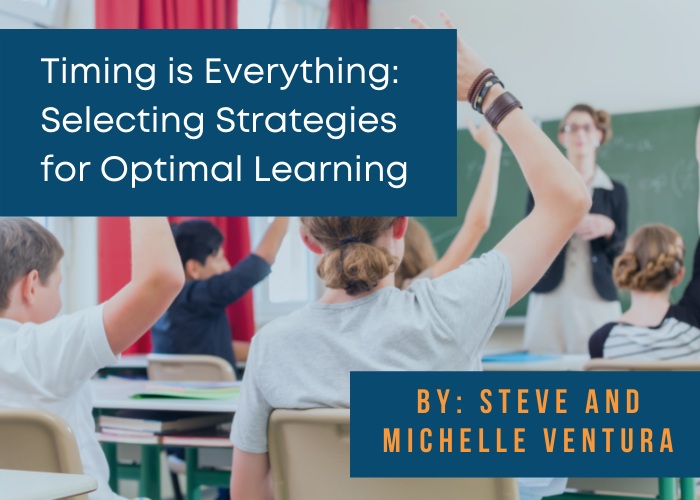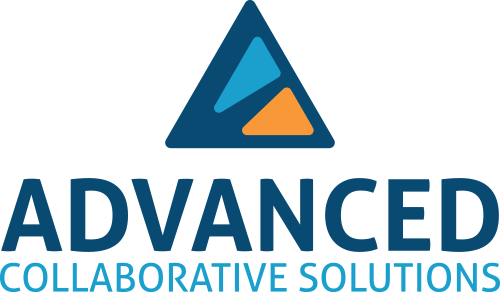Timing is Everything: Selecting Strategies for Optimal Learning

By: Steve and Michelle Ventura
Some instructional strategies, like success criteria, are unanimously touted as impactful while others get a bad rap. This leaves us to wonder: Out of the hundreds of strategies to choose from, which ones produce optimal learning?
What we don’t often talk about in the larger scheme of learning is the fact that when a strategy is introduced can have a significant bearing on how effective that strategy is in increasing student learning and, by proxy, student achievement. In a 2016 study, John Hattie and Gregory Donoghue introduced a model of learning to explore how various strategies aimed at increasing student achievement “can most effectively enhance performance when they are matched to the requirements of the task.” That is to say, when a strategy is introduced during the phase of the learning process in which it can best be absorbed by students and ultimately have the greatest impact on learning.
Surface, Deep, and Transfer Learning
Within Hattie and Donoghue’s model of learning, there are three main phases: surface, deep, and transfer. While these learning phases can sometimes overlap in practice (for example, surface and deep learning can be accomplished at the same time), it’s beneficial to think of them as distinct phases when planning which learning strategies are to be introduced at what point during a learning progression or unit of instruction. Teams who consider and discuss the phases of learning when collaboratively planning and implementing instruction are best equipped to select the strategies that have the highest probability of increasing student growth and achievement.
Knowledge Building
Surface learning is factual learning that is a prerequisite for deeper learning. To best describe surface learning, it’s helpful to compare it to deep learning. In Achievement Teams, we stress the use of learning progressions that contain prerequisite concepts and skills (surface) that lead to more advanced concepts and skills (deep). Therefore, surface learning strategies focus on recall or procedural information, such as explaining, naming, notetaking, and restating. Think of a situation where students are required to learn something new, like playing a musical instrument. The initial music lessons are focused on reading music, playing scales, and learning rhythms - all examples of surface learning. When students can eventually play entire passages and perform for others, they have achieved deep learning.
Once surface learning is acquired, students need to be able to store it in a way that allows it to be retrieved at will. One strategy that is helpful to consolidate surface learning is outlining, in which a student organizes thoughts or information related to a project or writing assignment. For example, using an outline at the beginning of the writing process helps to clarify ideas in a structured hierarchy while demonstrating to the teacher the thinking process behind a student’s writing.
Create Meaning
Deep learning is a product of surface learning. It occurs when students can revisit and recall surface-level knowledge and use it to obtain deeper learning. In other words, deep learning connects surface learning to help students progress to higher levels of achievement. As such, deep learning can be considered an extension of a student’s prior knowledge. As Hattie explains, students who “know what to do when they don’t know what to do'' have achieved deep learning.
When students have sufficiently acquired surface and deep learning, they need strategies to help them consolidate this knowledge so they can be more strategic in their approach to learning. A strategy used across content areas to bolster students’ understanding of a given topic is reciprocal teaching. With this strategy, teachers and students share in the teaching and discussion through a structured dialogue. Reciprocal teaching actively engages students in the learning process and teaches them to ask meaningful questions.
Applying Strategies and Understanding
It takes skill to transfer knowledge from one situation to the next. The transfer phase of learning is often the most elusive because transferring understanding to multiple situations is a dynamic process that requires learners to actively evaluate strategies and to adapt to situational information. As a result, finding the time to select strategies and design learning experiences to promote transfer learning can be frustrating.
One way that the transfer of learning can be evidenced is by asking students to identify similarities and differences. This strategy helps learners make connections to prior knowledge, compare information, and categorize concepts. Using compare and contrast strategies, such as metaphors and analogies, helps students to think critically and process new information. When students understand contextual similarities and differences, they learn how to consistently select the appropriate strategy for the situation at hand.
***
Now that you have a surface-level understanding of why timing is of the essence when planning instruction, we hope you can appreciate the value that the three phases can add as teams discuss, search, and apply strategies to help students learn at an accelerated pace. How will you encourage your teacher teams to use this knowledge to collaboratively plan instruction?
References:
Hattie, J., Donoghue, G. Learning strategies: a synthesis and conceptual model. npj Science Learn 1, 16013 (2016). https://doi.org/10.1038/npjscilearn.2016.13
UQx: LEARNx Deep Learning through Transformative Pedagogy (2017). University of Queensland, Australia. (an Open edX MOOC). Module 1:Surface and Deep Learning

